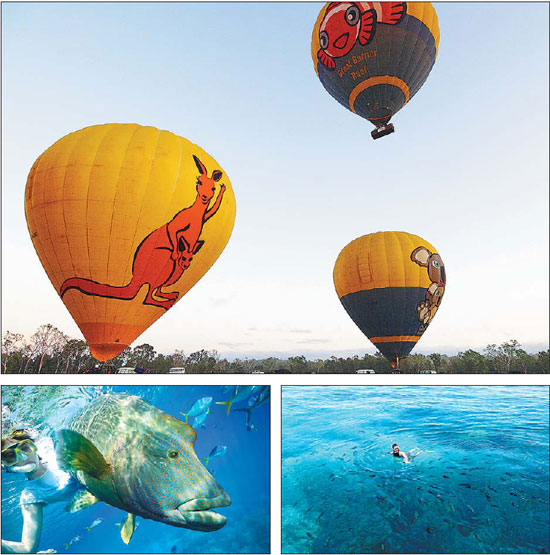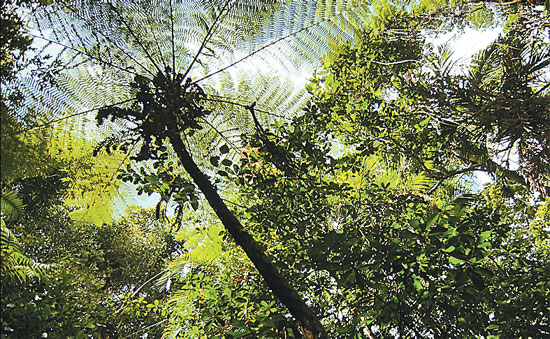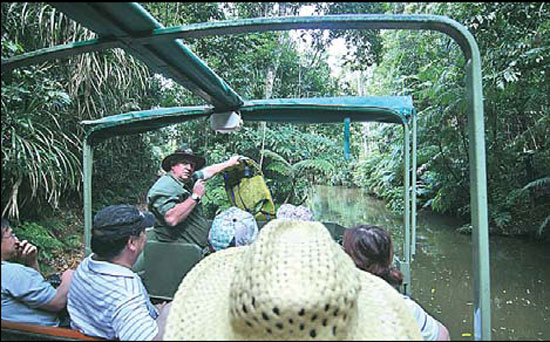Wonders high and low
Updated: 2013-01-10 07:38
By Ou Shuyi (China Daily)
|
||||||||
|
Cairns has a lot to offer to any discerning visitors - flying over the Atherton Tablelands on a hot-air balloon or taking a dip to explore the magic of the Great Barrier Reef. Photos by Ou Shuyi / China Daily; photo far left provided for China Daily |
Hot-air balloons leave visitors to Cairns, Australia gasping with delight. Then it's time to take a dive, Ou Shuyi reports.
The best way to catch the sunrise in Cairns is by going high up in the sky - in a hot-air balloon. Located on the northeast coast of Australia, Cairns is one of the best places in the world to go ballooning, with its spectacular scenery and ideal weather conditions.
For a first-timer like me, flying in a balloon is appealing but a little intimidating.
"It's probably the safest activity in the air," says local guide Mike Sha, who works with Hot Air Gold Coast & Cairns, one of the biggest ballooning operators in Australia.
"Whether you are 9 or 90, you can do it. We have flown passengers of all ages."
The Chinese-Australian tries to help ease my fear after picking me up at 4:30 am.

The flights usually take place early in the morning because balloons need cool, stable winds to operate effectively. The hours following sunrise are the most suitable before the heat of the day, Sha tells me.
The takeoff point is near the township of Mareeba, about one-hour drive from Cairns. Known for its temperate climate with about 300 sunny days a year, Mareeba is located on the fertile plateau of Atherton Tablelands.
The mountains of the Great Dividing Range act as a wind buffer against the sea breezes, which means Cairns has fewer flight cancelations than most locations in the world, Sha explains.
When we arrive at the launch site, it's about 6 am, and the dawn is just beginning to break over the stretch of farmlands.
A huge koala and a kangaroo are floating high in the air - two balloons that stand as tall as 10-story buildings, and each is emblazoned with a lively image of the Australian iconic animals.
After 30 minutes' waiting, it's time to get on board. I climb into the balloon basket, which is quite spacious for 16 passengers. The burner flares into action and the tethers are released. The next thing I know, we're inches off the ground.
The blasts from the burner warm my cheeks as we're rising higher and higher, watching trees shrink to broccoli florets, and cattle and sheep shrivel to little white cotton buds. Minutes later, we are floating gently over the morning mist.
The sun emerges over the horizon, its first rays of light revealing the tapestry of the farmlands.
Mango and lychee plantations, cane fields and coffee trees are all bathed in the spectacular golden light. The landscape comes to life as hundreds of kangaroos and wallabies jump around the bush.
I never expect that my first sight of the Australian wildlife would be from so high above. They look tiny but dazzlingly cute.
The flight is surprisingly gentle. I hardly feel the thrill of ascent from the tree level to about 1,000 meters.
It's also remarkably quiet. The silence is only interrupted by the birds' chirping, dogs' barking down below and the exclamations from my fellow passengers aboard.
Occasionally the pilot flares the propane burner. This is how he steers the balloon. By venting hot air to drop, or blasting heat into the balloon to rise, he can adjust the altitude to catch winds blowing the desired direction.
The one-hour flight comes to an end as the pilot makes radio contact with the ground crew, asking about the landing site and preparation.
Minutes later, we're back on the ground, safe and sound.
To enjoy the charm of Cairns, you should not only soar high up, but also go down under.
The Great Barrier Reef, one of Australia's best-kept secrets, is a dream destination and an underwater marvel.
A World Heritage site since 1981, it is acclaimed as one of the Earth's most biologically diverse places, home to 2,000 fish species, 4,000 mollusk species, more than 250 shrimp species and 400 coral species.
Sprawling off the east coast of Queensland for about 2,000 km from north to south, it covers an area of 348,000 sq km - bigger than the United Kingdom, Holland and Switzerland combined.
The site attracts about 1 million visitors from all over the world every year.
Some say it takes a lifetime to explore the 1,050 islands and cays in this vast expanse. Unfortunately, I have only one day to experience this natural wonder.
The Moore Reef, about 90 minutes' ride from Cairns, is popular among visitors who are short of time.
The great diversity of marine life and visibility make it one of the best diving and snorkeling spots on the outer edge of the Great Barrier Reef, says Eddie Loi, a guide who has worked with Sunlover Reef Cruises for eight years.
It's almost noon when our Sunlover catamaran gets to the destination - a large floating platform anchored on the Moore Reef. The sunlight turns the water into bright turquoise blue around the reef.
Facilities available onboard enable visitors of all ages - and of all swimming capabilities - to enjoy their reef trip, Loi says.
Those who don't want to get wet can relax on the sun deck and enjoy the panoramic view of the sea.
Kids and non-swimmers can still get up-close and personal with the reef by taking the semi-submersible and glass-bottom boat tours.
But for me, there's no better way than taking a dip into the crystal clear water.
The coral is alive and surprisingly colorful - brilliant yellow, pastel pink, mint green and intense blue. Schools of multihued fish dart in and out of lettuce coral, putting on a spectacular show underwater.
But the star residents of the reef are the giant clams - large enough to cradle a 6-year-old - and "Wally", a giant Maori Wrasse that's almost affectionately swimming up to my mask.
The two-hour snorkeling feels like it was over in seconds. My encounter with the Great Barrier Reef is too short. But that just gives me a perfect reason to visit again.
Contact the writer at oushuyi@chinadaily.com.cn.
|
Daintree rainforest is a World Heritage site and one of the world's oldest rainforests. |
|
Visitors take a tour on an amphibious vehicle in Rainforestation Nature Park. |
(China Daily 01/10/2013 page19)

 In Photos: 7.0-magnitude quake hits Sichuan
In Photos: 7.0-magnitude quake hits Sichuan
 Li Na on Time cover, makes influential 100 list
Li Na on Time cover, makes influential 100 list
 FBI releases photos of 2 Boston bombings suspects
FBI releases photos of 2 Boston bombings suspects
 World's wackiest hairstyles
World's wackiest hairstyles
 Sandstorms strike Northwest China
Sandstorms strike Northwest China
 Never-seen photos of Madonna on display
Never-seen photos of Madonna on display
 H7N9 outbreak linked to waterfowl migration
H7N9 outbreak linked to waterfowl migration
 Dozens feared dead in Texas plant blast
Dozens feared dead in Texas plant blast
Most Viewed
Editor's Picks

|

|

|

|

|

|
Today's Top News
Live report: 7.0-magnitude quake hits Sichuan, heavy casualties feared
Boston suspect cornered on boat
Cross-talk artist helps to spread the word
'Green' awareness levels drop in Beijing
Palace Museum spruces up
First couple on Time's list of most influential
H7N9 flu transmission studied
Trading channels 'need to broaden'
US Weekly

|

|










